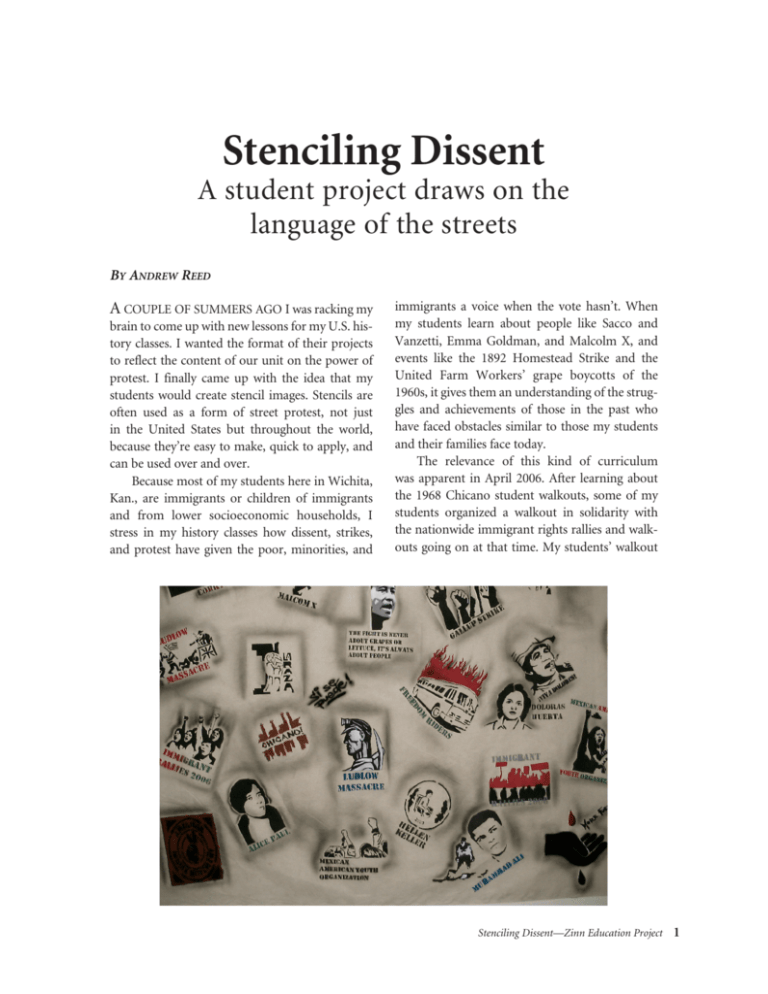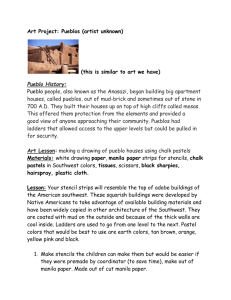Stenciling Dissent - Zinn Education Project
advertisement

Stenciling Dissent A student project draws on the language of the streets By Andrew Reed A couple of summers ago I was racking my brain to come up with new lessons for my U.S. history classes. I wanted the format of their projects to reflect the content of our unit on the power of protest. I finally came up with the idea that my students would create stencil images. Stencils are often used as a form of street protest, not just in the United States but throughout the world, because they’re easy to make, quick to apply, and can be used over and over. Because most of my students here in Wichita, Kan., are immigrants or children of immigrants and from lower socioeconomic households, I stress in my history classes how dissent, strikes, and protest have given the poor, minorities, and immigrants a voice when the vote hasn’t. When my students learn about people like Sacco and Vanzetti, Emma Goldman, and Malcolm X, and events like the 1892 Homestead Strike and the United Farm Workers’ grape boycotts of the 1960s, it gives them an understanding of the struggles and achievements of those in the past who have faced obstacles similar to those my students and their families face today. The relevance of this kind of curriculum was apparent in April 2006. After learning about the 1968 Chicano student walkouts, some of my students organized a walkout in solidarity with the nationwide immigrant rights rallies and walkouts going on at that time. My students’ walkout Stenciling Dissent—Zinn Education Project 1 involved about 500 young people from different for Mexican migrant workers in the 1930s), Fred Wichita high schools; it ended up on the front Korematsu (Japanese American who resisted relopage of the Wichita Eagle and was the top story on cation to an internment camp during World War all three local evening newscasts. I took no part in II), and Philip and Daniel Berrigan (Catholic organizing the student walkout and, contrary to priests who protested against the Vietnam War); the superintendent’s claims, no other adults orgaorganizations like the Brown Berets (Chicano nized it either; it was led by students. On the other rights activists in the 1960s who were inspired by hand, I do believe that the history curriculum they the Black Panthers); and events like the Ludlow learned in my class gave them a massacre (famous labor strike in sense that they were capable of 1914) and even the recent immiBeing artistically doing it. The following year, I gration rights rallies. challenged, I figured if wanted to do something to keep I foreshadowed the stenalive my students’ spirit of protest. cil project by including lessons I could make a decent Our power-of-protest unit throughout the school year on stencil then any of my dovetailed with a school district the general use of art (fine art, students could, too. requirement for a research-based music, video, and other types of persuasive essay. I decided to ask media) as a means of protest in students to choose an individual, the past. For example, we listened group, or event essential to the history of dissent to and analyzed songs of the Industrial Workin the United States. Their project would entail ers of the World (IWW), connecting the lyrics researching their chosen topic, writing the essay, to the importance of uniting workers and giving creating and printing a stencil, and distilling the them a voice during the early 1900s. Then, while essence of their topic into a paragraph to accomlearning about the 1920s Red Scare, the students pany the stencil. interpreted the messages about injustice in a Diego The list of topics I gave students included Rivera mural. individuals like Emma Tenayuca (labor organizer One Step Ahead of the Class While the students researched their topics and wrote and rewrote their essays, I prepared for the stencil piece of the project. I knew that before I could ask my students to create these stencils, I would have to make some myself to get an idea of how difficult and time-consuming it might be. Being artistically challenged, I figured if I could make a decent stencil then any of my students could, too. My first stencil was of the abolitionist Henry David Thoreau. I spray-painted it on my podium along with one of his quotes: “It is not desirable to cultivate a respect for the law so much as a respect for right.” (Thoreau was jailed for refusing to pay a tax to support the U.S. war against Mexico—a war he believed was launched to spread slavery.) Next was an image of Emma Goldman, then Subcomandante Marcos of the Zapatista movement, and on and on. By the time I was ready to show my students how to create the stencils, many of them already had an idea just from watching me so many times. Stenciling Dissent—Zinn Education Project 2 Before students started their stencils, we watched video clips on stenciling. I found a couple of five-minute clips on YouTube to show as a visual introduction to stenciling. One video was a tutorial on creating stencils. Another showed that stencils were used throughout the world as a form of protest, especially in Latin America. I chose spray paint to give my students more of a feeling of making street art. Because stenciling on public spaces without permission is illegal and, of course, I was not advocating that my students do that, I figured painting the stencils on one big canvas would be the closest we could get to doing it on the streets. There was a sense of nervous anticipation as The Stencils Take Life students applied their stencils to First, students searched for an the canvas. They would have only image on the web to make their one shot to get it right. Too much “It was nice to see stencil. Some students found paint would cause a stencil to people learning ready-made designs, while others run; too little paint would make had to modify the images. The it look blurry. We worked outabout Mexicans easiest way to modify an image to doors and wore masks because for a change.” create a stencil is to load the image spray paint fumes are dangerous. into Microsoft Word, adjust it to Each student laid a stencil onto higher contrast, and experiment the canvas, applied the paint, and with the brightness until it looks more like a stenslowly removed the stencil to reveal the image on cil. Once we reviewed the basic concepts, the stuthe canvas. I loved seeing my students’ eyes light dents were able to design their images fairly easily. up, watching them smile, and listening as they The next stage was to create the actual stenbragged about the quality of their images. cil. I provided each student with a piece of 8.5- x Some moments were magical: Pedro was fairly 11-inch transparency film. Students laid the transnew to the school and didn’t know many people parency over the printed image and traced it onto yet. When it was his turn to spray his stencil he did the transparency. Transparency film is good to use it with ease, as if he had done it many times before. because it’s easy to cut, it’s thin, and paint won’t I asked him if he had painted stencils previously. bleed through. If students wanted to make a stencil larger than 8.5- x 11-inch they used an 11- x 17-inch file folder. I then gave students small utility knives to cut out their stencils, along with stern warnings about safety. (I’m happy to say that not one student had an accident; I wish I could say the same for myself.) Students had to make a stencil image to represent their topic and also a stencil cutout of the name of the person, group, or event they chose. Given the time constraints, some students used the stencil fonts preinstalled on the computers, while others made their own by hand. A variety of interesting stencil fonts can be downloaded for free from the web. After students found their image, manipulated it, traced it to transparency, and then cut it out, they were ready to paint. Instead of having students make individual posters, I bought a giant 7- x 12-foot canvas as a “wall.” We used spray paint to apply the stencil images, although other kinds of paint can be used. Stenciling Dissent—Zinn Education Project 3 He explained that he works with his brother in a a paragraph distilling the significance—in terms of body shop airbrushing cars, which is a similar skill. the history of dissent in the United States—of the He then spent the next 15 minutes teaching the person, group, or event represented in his or her other students and me the proper techniques for stencil. This one-paragraph description was a big applying spray paint. That seemed to be the icechallenge for many students, taking pages worth of breaker between him and the rest of the students; research and condensing the most important parts from then on he was more social in class. down to five or six sentences. In a hallway display, Another student, Ricardo students don’t have time to stand Valdez, an amazing graffiti artist and read a lengthy report about, who has done a lot of street art in say, Cesar Chavez; they have to be Mexico City, painted additional able to get information about him I wanted to shine art on the canvas to give it more as they walk by. My students reala light on great of a street art look. ized that in describing why Cesar people who were I have never had students so Chavez was an important figure into doing a history class project in American protest history, they lesser known. as they were into this. They loved couldn’t start with where he was it. Some students wanted to make born, what schools he attended as more than one stencil. They would a child, and so forth. They had to show up in class with the stencil of Che Guevara or stick to the boycotts, hunger strikes, arrests, and a Zapatista that they made at home. Even though lasting impact of his actions. It was the students, protesting the Iraq war was not on the list of topnot me, who figured out what to teach to others. ics, some students made antiwar stencils on their For example, my student Odalis Sosa distilled own time to put on our class canvas. Emma Goldman’s life into this summary: Stencils for Justice We displayed the canvas in the school’s hallway for all to see. Next to the canvas, each student posted Emma Goldman, 1869–1940 Anarchist, feminist, antiwar activist Emma Goldman made [it] her life to fight for the rights of women, immigrants, and all others in the United States who were being oppressed. In 1893, Emma was put into prison for “inciting a riot” when she wanted unemployed workers to stand up for their rights. In 1911, she was imprisoned for distributing birth control literature. In 1917, Emma was imprisoned for a third time for protesting against World War I and wanting people to refuse the draft. Emma Goldman’s protest influenced many people during her time and later to fight for the rights of the oppressed. The canvas display was the eye-catcher, while students’ paragraphs posted to the side of the display were the education for onlookers. As my students watched others studying their “wall,” they recognized how art can be an effective means to reach other people. A former student, Alma, told me how much she wished we’d done this while she was in my class. But she asked, “Why isn’t Martin Stenciling Dissent—Zinn Education Project 4 Luther King Jr. or Rosa Parks on the display?” I told her that those historical figures definitely fit into the theme of the project, but they were not on the list because I wanted to shine a light on great people who were lesser known. Other students, and teachers, too, talked to me about the people or events we failed to put on the display. I wasn’t offended; it made me feel that the project served its purpose. As people looked at the display and read the information, they began to think: “Who else should be up there? Who else have I learned about whose protest was important to U.S. history?” A week after the display went up, my classes discussed the project and what they observed. Eduardo, an immigrant from Durango, Mexico— “and proud of it,” as he reminded others all the time—said, “It was nice to see some people learning about Mexicans for a change.” I asked the students if they thought others would have paid as much attention to the display if we had used more traditional visuals instead of stencils. They gave a resounding no. They said that the purpose of using political stencils on the streets was to get people’s attention. The display was well received by students and staff at the school. Students stopped in the halls to observe and talk to each other about why images of Dolores Huerta or the Freedom Riders looked so cool. I received emails from teachers praising the project. I even received emails from the art teachers praising students’ work. With antiwar stencils on the canvas, it did not completely escape negative reactions. One staff member told me that he wanted to go home and get his paint so he could paint over the whole thing. A couple of others decided the display was un-American, but most seemed to understand that dissent is what makes us Americans. Some staff members had preconceived notions about street art. They felt that any street art is graffiti and any graffiti is gangrelated. But when they saw how street art was used for an educational purpose, many told me they gained a new appreciation for it. Especially in an urban school where students appreciate graffiti and other street art, stencils hold the potential to engage students. Youth can create something that might get them in trouble on the streets but an A in the classroom. And students can use stencils in other ways: to create their own shirts, posters, book covers, or postcards. Whether in a school or on the streets, stencils—at least political ones—can catch onlookers’ attention and make them think. Resources Stencil Revolution: A Stencil Art Community Resource: www.stencilrevolution.com. To see how history has been represented in street art, check out Justseeds: Visual Resistance Artists’ Cooperative: www.justseeds.org YouTube links: www.youtube.com/watch?v=6c3w1ztnwW8 www.youtube.com/watch?v=XXSg8BApBwA &feature=relatedwww.youtube.com/watch www.youtube.com/watch?v=Q3Zb2aJ7CG8 Andrew Reed (bajiboy@gmail.com) currently teaches at Niwot High School in Colorado. When this project was created, he was teaching at East High School in Wichita, Kan. This article was previously published in Rethinking Schools magazine. To order back issues of the magazine or to subscribe, visit www.rethinkingschools.org or call 800-6694192. This article is offered for use in educational settings as part of the Zinn Education Project, a collaboration of Rethinking Schools and Teaching for Change, publishers and distributors of social justice educational materials. Contact Rethinking Schools directly for permission to reprint this material in course packets, newsletters, books, or other publications. For more information: Rethinking Schools www.rethinkingschools.org 800-669-4192 Teaching for Change www.teachingforchange.org 800-763-9131 Stenciling Dissent—Zinn Education Project 5








